
Donglin Temple is a Buddhist temple approximately 20 kilometres (12 mi) from Jiujiang, in the north of Jiangxi province, China. Built in 386 CE at the foot of Mount Lu by Huiyuan, founder of the Pure Land Buddhism, it is well known for how long it has stood without collapsing.
Wanfu Temple is a Buddhist temple on Mount Huangbo in Fuqing, Fujian, China. It is famous as the original temple of Yinyuan Longqi, the temple's 33rd abbot and a Chan master. He later travelled to Japan with his disciple Muyan to found the Japanese Ōbaku school of Zen.

The Hall of Guru or Guru Hall, also known as the Founder's Hall, is the most important annex halls in Chinese Buddhist temples for enshrining masters of various Buddhism schools. It is encountered throughout East Asia, including in some Japanese Buddhist Kaisandos (開山堂). The Hall of Guru is generally situated to the west of the Mahavira Hall. Chan Buddhist temples usually have the Hall of Guru, which is followed by other schools' temples. Therefore, three statues are always enshrined in the Guru Hall, namely the founder of the school, the senior monk who make significant contributions to the establishment of the school and the builder of the temple. Generally the Guru Hall in Chan Buddhism temples has Bodhidharma enshrined in the middle, the 6th Master Huineng's (638-713) statue on the left and Master Baizhang Huaihai's (720-814) statue on the right. Patriarch Bodhidharma and Damo for short, from south of ancient India, was the original ancestor of Chan Buddhism. The 6th Master Dajian Huineng was the actual founder of Chan Buddhism. After him, the Chan Buddhism in ancient China was almost changed and had far-reaching influence on Chinese traditional culture. Baizhang Huaihai was the third generation disciple of Huineng and his main achievements included: applying Chan Buddhism into practice, creating a set of regulations for Chan Buddhist temples and contributing to the steady development of Chan Buddhism.
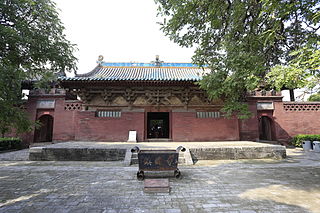
The Hall of Four Heavenly Kings or Four Heavenly Kings Hall, referred to as Hall of Heavenly Kings, is the first important hall inside a shanmen in Chinese Buddhist temples and is named due to the Four Heavenly Kings statues enshrined in the hall.
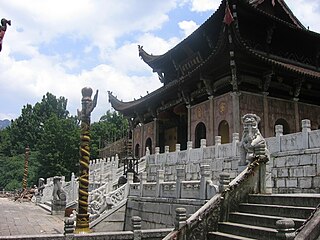
The Hall of Kṣitigarbha or Kṣitigarbha Hall is one of the most important annexed halls in Chinese Buddhist temples. It is named after its primary function of enshrining the bodhisattva Kṣitigarbha and sometimes doubles as the temple mausoleum.

The Hall of Guanyin or Guanyin Hall is the most important annex halls in Chinese Buddhist temples and mainly for enshrining Guanyin (Avalokiteśvara). Guanyin, also called "Guanshiyin" (觀世音), "Guanshizizai" (觀世自在), "Guanzizai" (觀自在), etc., is the attendant of Amitabha and one of the "Western Three Saints" (西方三聖). Guanyin is renowned for his mercy and sympathy. According to Chapter of the Universal Gate of Avalokiteśvara Bodhisattva (《觀世音菩薩普門品》), if people are in danger, they just need to call his name and he will hear them and go to save them. Since he has many manifestations, different places enshrine different statues of Saint Guanyin (圣觀音), Guanzizai (觀自在), and Thousand-armed and eyed Guanyin (千手千眼觀音菩薩).
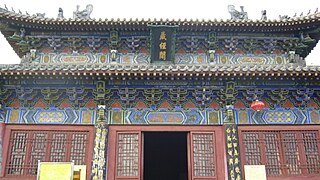
A Buddhist texts library is a large building in Chinese Buddhist temples which is built specially for storing The Chinese Buddhist Canon (大藏經). It is encountered throughout East Asia, including in some Japanese Buddhist Kyōzōs (経蔵). The Chinese Buddhist Canon is the total body of Buddhist literature deemed canonical and was called "all the sutras" (一切經) in the ancient time. With four thousand kinds, it includes Āgama (經), Vinaya (律) and Abhidharma (論) texts. Āgama are theories made by Buddha for disciples to practice, Vinaya are the rules formulated by Buddha for believers and Abhidharma is the collection of theories explanations by Buddha's disciples.

The Dharma Hall, also known as Lecture Hall, is an important building in Han Chinese Buddhist temples. The Dharma Hall is the place for senior monks to preach and generally ranks right after the Mahavira Hall.
Guanyin Ancient Temple is a Buddhist temple located in Chuanying District of Jilin City, Jilin, China.

Heng and Ha are two generals of the Shang dynasty in Chinese mythology, featured within the 16th-century Chinese fantasy novel Investiture of the Gods. These two fictional characters were created by the author of Investiture of the Gods based upon the vajra warriors, two guards of Buddhist temples in East Asia, and have become their common names in Chinese.

Daci'en Temple is a Buddhist temple located in Yanta District, Xi'an, Shaanxi. The temple is the cradle of East Asian Yogācāra in China. It is notable for the Giant Wild Goose Pagoda. The pagoda was originally built by the monk Xuanzang, whose pilgrimage to India inspired the novel Journey to the West. Alongside Daxingshan Temple and Jianfu Temple, it was one of the three sutras translation sites (三大译经场) in the Tang dynasty.

Xiangji Temple is a Buddhist temple located in Chang'an District of Xi'an, Shaanxi. The temple is regarded as the cradle of Pure Land Buddhism.

Meidaizhao Monastery or Meidaizhao Lamasery is a Tibetan Buddhist temple located in Tumed Right Banner, Baotou, Inner Mongolia, China.
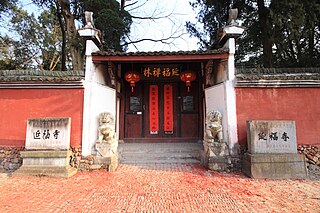
Yanfu Temple or Yanfu Chan Temple is a Buddhist temple located in Wuyi County, Zhejiang, China. The Mahavira Hall is the earliest Yuan dynasty (1271–1368) architecture and one of the three Yuan dynasty wooden architecture in Jiangnan.

The Hall of Sangharama Palace is an important building in Han Chinese Buddhist temples. It is the east annex hall of the Mahavira Hall. The term "Sangharama" (僧伽藍摩) refers to "gardens of monks" (眾園). In Buddhism, it originally refers to constructing the base of monks' dormitories (僧舍) and later it refers to the general term of temples, including land and buildings.

The Bell tower is an important building in Han Chinese Buddhist temples. Together with Drum tower, they are usually placed on both sides of the Hall of Four Heavenly Kings. It is usually on the left side while the Drum tower is usually on the right side. It is general a three-storey pavilion with a large bell hung in it. The loud and melodious sound of the bell is often used to convene monks. In each morning and night, beating the bell 108 times symbolizes the relief of the 108 kinds of trouble in the human world.
The Arhat Hall is a hall used for enshrining an arhat or arhats in Chinese Buddhist temples. Arhat is another term for Arahant, one who has gained insight into the true nature of existence and has achieved Enlightenment and liberated from the endless cycle of rebirth. In Mahayana Buddhism, arhats rank the third position in Buddhism, only below the Buddhas and Bodhisattvas. In Theravada Buddhism, Siddhartha Gautama or The Buddha is the first of the arahats, while his disciples who reach the goal by following his noble path also become arahats.
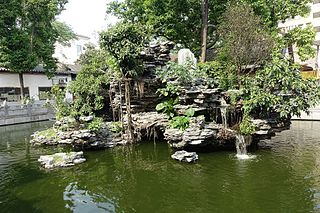
A Free Life Pond is a type of pond at Han Chinese Buddhist temples. It is usually located in front of the Shanmen or the Hall of Four Heavenly Kings. The Free Life Pond embodies Buddhist thoughts of compassion and understanding of all living beings.
The Hall of Bhaisajyaguru is the hall to enshrine Bhaisajyaguru, who is also named "Yaoshifo" for short in Chinese Buddhism.

The drum tower is an important building in Han Chinese Buddhist temples. Together with a bell tower, they are usually placed on both sides of the Hall of Four Heavenly Kings. It is usually located on the right side while the bell tower is usually located on the left side. It is general a three-storey pavilion with a big drum placed on it. When it is beaten, it sounds grandly and loudly. Buddhist temples set times to beat the drums to inform the time and also wake people up.















